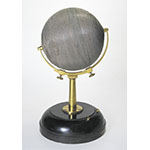Model Earth consisting of a wooden globe with copper wire wound in grooves latitudinally around the globe. Supported on a brass pedestal mounted on a wooden base. The globe can be rotated manually and tilted at different angles. When connected to a battery by means of the terminals at the base, it generates a magnetic field that can be detected by a magnetic dip needle, held by a separate support (missing). The globe can thus simulate a miniature Earth, complete with the terrestrial magnetic field affecting compasses.
In 1600, William Gilbert demonstrated magnetic dip with his "terrella," i.e., a spherical lodestone. Leopoldo Nobili conceived this electromagnetic model in 1822, while André-Marie Ampère was formulating the relationship between electricity and magnetism. The instrument is commonly known as the "Barlow globe" after Peter Barlow, who demonstrated his device at the Royal Institution of London in 1824. Provenance: Lorraine collections.










